语用学名词解释
语用学的专业名词解释
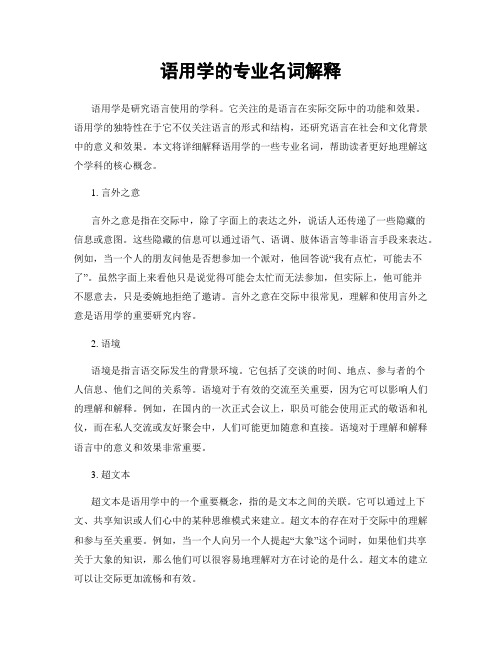
语用学的专业名词解释语用学是研究语言使用的学科。
它关注的是语言在实际交际中的功能和效果。
语用学的独特性在于它不仅关注语言的形式和结构,还研究语言在社会和文化背景中的意义和效果。
本文将详细解释语用学的一些专业名词,帮助读者更好地理解这个学科的核心概念。
1. 言外之意言外之意是指在交际中,除了字面上的表达之外,说话人还传递了一些隐藏的信息或意图。
这些隐藏的信息可以通过语气、语调、肢体语言等非语言手段来表达。
例如,当一个人的朋友问他是否想参加一个派对,他回答说“我有点忙,可能去不了”。
虽然字面上来看他只是说觉得可能会太忙而无法参加,但实际上,他可能并不愿意去,只是委婉地拒绝了邀请。
言外之意在交际中很常见,理解和使用言外之意是语用学的重要研究内容。
2. 语境语境是指言语交际发生的背景环境。
它包括了交谈的时间、地点、参与者的个人信息、他们之间的关系等。
语境对于有效的交流至关重要,因为它可以影响人们的理解和解释。
例如,在国内的一次正式会议上,职员可能会使用正式的敬语和礼仪,而在私人交流或友好聚会中,人们可能更加随意和直接。
语境对于理解和解释语言中的意义和效果非常重要。
3. 超文本超文本是语用学中的一个重要概念,指的是文本之间的关联。
它可以通过上下文、共享知识或人们心中的某种思维模式来建立。
超文本的存在对于交际中的理解和参与至关重要。
例如,当一个人向另一个人提起“大象”这个词时,如果他们共享关于大象的知识,那么他们可以很容易地理解对方在讨论的是什么。
超文本的建立可以让交际更加流畅和有效。
4. 礼貌原则礼貌原则是语用学研究的一个重要方面,它涉及到人们在交际中如何使用语言来维持社会和谐。
礼貌原则包括尊重他人的面子、避免冲突、表达感谢和道歉等。
不同文化有不同的礼貌原则,因此,了解和遵守礼貌原则对于跨文化交际尤为重要。
例如,在一些文化中,人们可能会使用更加间接和委婉的方式表达自己的观点,以避免伤害他人的感情。
5. 言外行为言外行为是指通过语言之外的行为来传递信息的方式。
语用学重点
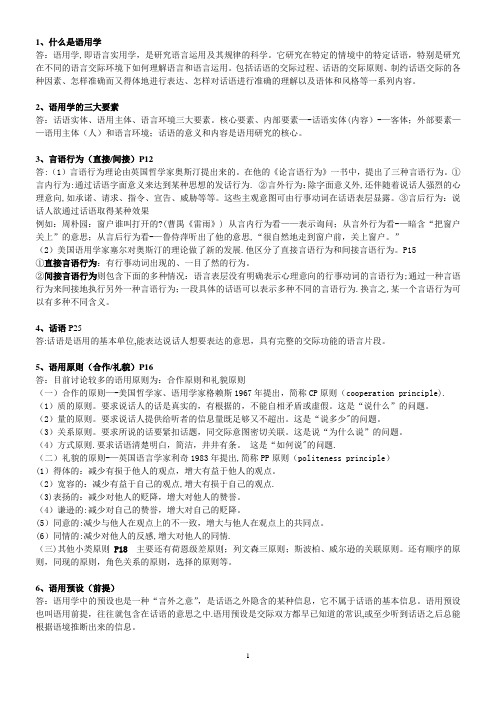
1、什么是语用学答:语用学,即语言实用学,是研究语言运用及其规律的科学。
它研究在特定的情境中的特定话语,特别是研究在不同的语言交际环境下如何理解语言和语言运用。
包括话语的交际过程、话语的交际原则、制约话语交际的各种因素、怎样准确而又得体地进行表达、怎样对话语进行准确的理解以及语体和风格等一系列内容。
2、语用学的三大要素答:话语实体、语用主体、语言环境三大要素。
核心要素、内部要素—-话语实体(内容)-—客体;外部要素——语用主体(人)和语言环境;话语的意义和内容是语用研究的核心。
3、言语行为(直接/间接)P12答:(1)言语行为理论由英国哲学家奥斯汀提出来的。
在他的《论言语行为》一书中,提出了三种言语行为。
①言内行为:通过话语字面意义来达到某种思想的发话行为. ②言外行为:除字面意义外,还伴随着说话人强烈的心理意向,如承诺、请求、指令、宣告、威胁等等。
这些主观意图可由行事动词在话语表层显露。
③言后行为:说话人欲通过话语取得某种效果例如:周朴园:窗户谁叫打开的?(曹禺《雷雨》) 从言内行为看——表示询问;从言外行为看-—暗含“把窗户关上”的意思;从言后行为看-—鲁侍萍听出了他的意思,“很自然地走到窗户前,关上窗户。
”(2)美国语用学家塞尔对奥斯汀的理论做了新的发展.他区分了直接言语行为和间接言语行为。
P15①直接言语行为:有行事动词出现的、一目了然的行为。
②间接言语行为则包含下面的多种情况:语言表层没有明确表示心理意向的行事动词的言语行为;通过一种言语行为来间接地执行另外一种言语行为;一段具体的话语可以表示多种不同的言语行为.换言之,某一个言语行为可以有多种不同含义。
4、话语P25答:话语是语用的基本单位,能表达说话人想要表达的意思,具有完整的交际功能的语言片段。
5、语用原则(合作/礼貌)P16答:目前讨论较多的语用原则为:合作原则和礼貌原则(一)合作的原则—-美国哲学家、语用学家格赖斯1967年提出,简称CP原则(cooperation principle). (1)质的原则。
普通语言学名词解释
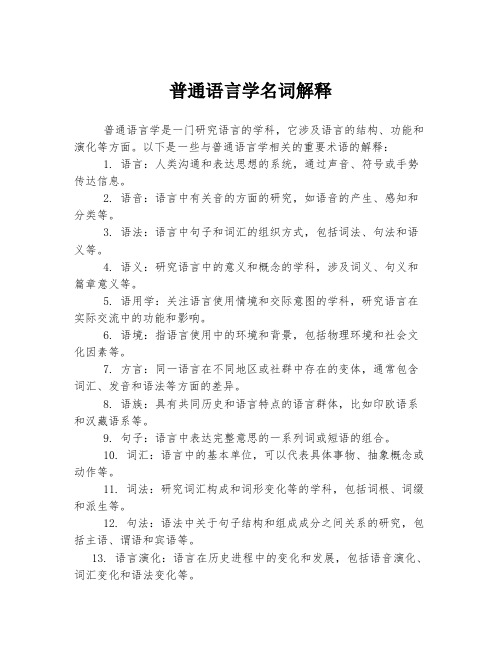
普通语言学名词解释
普通语言学是一门研究语言的学科,它涉及语言的结构、功能和演化等方面。
以下是一些与普通语言学相关的重要术语的解释:
1. 语言:人类沟通和表达思想的系统,通过声音、符号或手势传达信息。
2. 语音:语言中有关音的方面的研究,如语音的产生、感知和分类等。
3. 语法:语言中句子和词汇的组织方式,包括词法、句法和语义等。
4. 语义:研究语言中的意义和概念的学科,涉及词义、句义和篇章意义等。
5. 语用学:关注语言使用情境和交际意图的学科,研究语言在实际交流中的功能和影响。
6. 语境:指语言使用中的环境和背景,包括物理环境和社会文化因素等。
7. 方言:同一语言在不同地区或社群中存在的变体,通常包含词汇、发音和语法等方面的差异。
8. 语族:具有共同历史和语言特点的语言群体,比如印欧语系和汉藏语系等。
9. 句子:语言中表达完整意思的一系列词或短语的组合。
10. 词汇:语言中的基本单位,可以代表具体事物、抽象概念或动作等。
11. 词法:研究词汇构成和词形变化等的学科,包括词根、词缀和派生等。
12. 句法:语法中关于句子结构和组成成分之间关系的研究,包括主语、谓语和宾语等。
13. 语言演化:语言在历史进程中的变化和发展,包括语音演化、词汇变化和语法变化等。
14. 语言习得:人类通过接触和经验逐渐学习掌握语言的过程。
15. 第二语言习得:学习其他语言的过程,通常指非母语的学习。
这些术语是普通语言学研究中常用的概念,有助于我们理解和探索语言的本质和使用。
语言学纲要名词解释

语言学纲要名词解释语言学纲要名词解释:语言学:语言学是研究语言的科学,旨在探讨语言的结构、发展、使用和认知等方面的规律和现象。
声音:声音是由空气振动引起的,可通过耳朵感知得到的物理现象。
在语言学中,声音是语言的基本单位,用于构成语音。
语音:语音是语言学研究的一个分支,研究语言中的音素、音位等声音单位的特征和规律。
音素:音素是语音学研究的一个基本概念,指在一个语言中差异能够区分词义的最小声音单位。
语言声调:语言声调是描述不同语言或方言中声调变化和使用的规律和现象。
音韵学:音韵学是语言学中一个研究语音的分支,研究不同语音之间的相互关系和规律。
辅音:辅音是指在发音过程中需要舌头、唇等口腔器官接触或与之产生摩擦的音素。
元音:元音是指发音时空气通过喉咙、口腔等器官自由通过而不产生摩擦的音素。
音系:音系是指一个语言中所有音素的组合和制约关系。
语法:语法是研究语言结构和规则的科学,包括句法、词法等方面。
句法:句法是语法的一个分支,研究句子在语言中的组织结构和句子成分之间的关系。
词法:词法是研究词的结构和形态变化的学科,包括词的构成、词类等方面。
形态学:形态学是语言学研究的一个分支,研究词的形态构成、词的形态变化等现象。
句子:句子是语言中表达一个完整意思的基本单位。
意义:意义是语言符号所包含的符号和概念的含义。
语义学:语义学是研究语言符号意义的学科,包括词义学和句义学等方面。
语用学:语用学是研究语言使用情境和交际行为的学科,关注社会语言学、会话分析等方面。
会话分析:会话分析是语用学的一个分支,研究对话结构、对话参与者行为等方面。
语言地理学:语言地理学是研究语言在地理分布和变化中的规律和影响的学科。
语言变异学:语言变异学是研究语言变异和变体使用的学科。
语言习得:语言习得是研究人类如何学习和掌握第一语言和第二语言的过程和机制的学科。
语言分析:语言分析是对语言进行形态、句法、语用等方面的分析。
语言教学:语言教学是指通过教育和教学方法来教授和学习语言的过程。
语用学纲要 中的名词解释
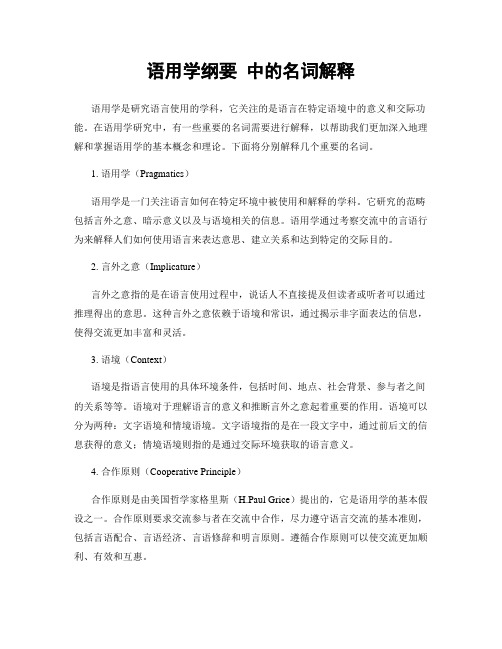
语用学纲要中的名词解释语用学是研究语言使用的学科,它关注的是语言在特定语境中的意义和交际功能。
在语用学研究中,有一些重要的名词需要进行解释,以帮助我们更加深入地理解和掌握语用学的基本概念和理论。
下面将分别解释几个重要的名词。
1. 语用学(Pragmatics)语用学是一门关注语言如何在特定环境中被使用和解释的学科。
它研究的范畴包括言外之意、暗示意义以及与语境相关的信息。
语用学通过考察交流中的言语行为来解释人们如何使用语言来表达意思、建立关系和达到特定的交际目的。
2. 言外之意(Implicature)言外之意指的是在语言使用过程中,说话人不直接提及但读者或听者可以通过推理得出的意思。
这种言外之意依赖于语境和常识,通过揭示非字面表达的信息,使得交流更加丰富和灵活。
3. 语境(Context)语境是指语言使用的具体环境条件,包括时间、地点、社会背景、参与者之间的关系等等。
语境对于理解语言的意义和推断言外之意起着重要的作用。
语境可以分为两种:文字语境和情境语境。
文字语境指的是在一段文字中,通过前后文的信息获得的意义;情境语境则指的是通过交际环境获取的语言意义。
4. 合作原则(Cooperative Principle)合作原则是由美国哲学家格里斯(H.Paul Grice)提出的,它是语用学的基本假设之一。
合作原则要求交流参与者在交流中合作,尽力遵守语言交流的基本准则,包括言语配合、言语经济、言语修辞和明言原则。
遵循合作原则可以使交流更加顺利、有效和互惠。
5. 指代(Reference)指代是指使用语言中的词语来指称现实世界中的事物、概念或实体。
在语用学中,指代研究包括指代的语用功能、指代的形式选择以及指代的语境依赖性等等。
指代在交际中起着很重要的作用,识别和理解指代可以帮助我们构建语言信息的连贯性和完整性。
6. 指涉(Deixis)指涉与指代类似,但更加具体,它指的是在交际中通过语言指示和引用特定的人、事、物或地点。
语用学言语行为的名词解释
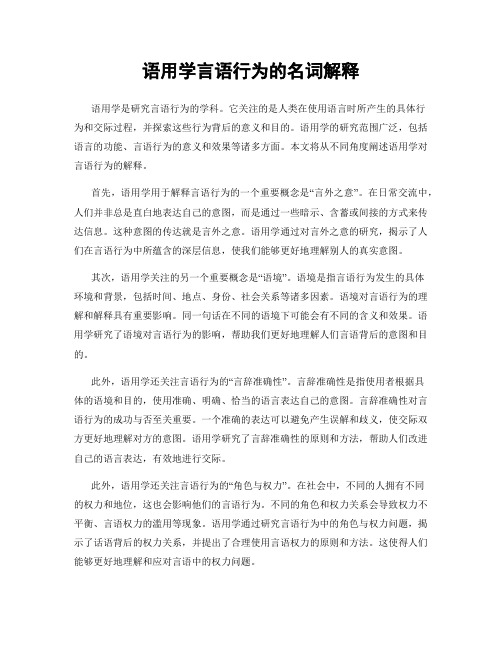
语用学言语行为的名词解释语用学是研究言语行为的学科。
它关注的是人类在使用语言时所产生的具体行为和交际过程,并探索这些行为背后的意义和目的。
语用学的研究范围广泛,包括语言的功能、言语行为的意义和效果等诸多方面。
本文将从不同角度阐述语用学对言语行为的解释。
首先,语用学用于解释言语行为的一个重要概念是“言外之意”。
在日常交流中,人们并非总是直白地表达自己的意图,而是通过一些暗示、含蓄或间接的方式来传达信息。
这种意图的传达就是言外之意。
语用学通过对言外之意的研究,揭示了人们在言语行为中所蕴含的深层信息,使我们能够更好地理解别人的真实意图。
其次,语用学关注的另一个重要概念是“语境”。
语境是指言语行为发生的具体环境和背景,包括时间、地点、身份、社会关系等诸多因素。
语境对言语行为的理解和解释具有重要影响。
同一句话在不同的语境下可能会有不同的含义和效果。
语用学研究了语境对言语行为的影响,帮助我们更好地理解人们言语背后的意图和目的。
此外,语用学还关注言语行为的“言辞准确性”。
言辞准确性是指使用者根据具体的语境和目的,使用准确、明确、恰当的语言表达自己的意图。
言辞准确性对言语行为的成功与否至关重要。
一个准确的表达可以避免产生误解和歧义,使交际双方更好地理解对方的意图。
语用学研究了言辞准确性的原则和方法,帮助人们改进自己的语言表达,有效地进行交际。
此外,语用学还关注言语行为的“角色与权力”。
在社会中,不同的人拥有不同的权力和地位,这也会影响他们的言语行为。
不同的角色和权力关系会导致权力不平衡、言语权力的滥用等现象。
语用学通过研究言语行为中的角色与权力问题,揭示了话语背后的权力关系,并提出了合理使用言语权力的原则和方法。
这使得人们能够更好地理解和应对言语中的权力问题。
最后,语用学还关注言语行为的“言语规范性”。
言语规范性是指在特定社会和文化背景下,人们对言语行为的规定和期望。
不同社会和文化对言语行为有着不同的规范和要求,这种规范性对人们的言语行为产生了重要影响。
英语语言学名词解释
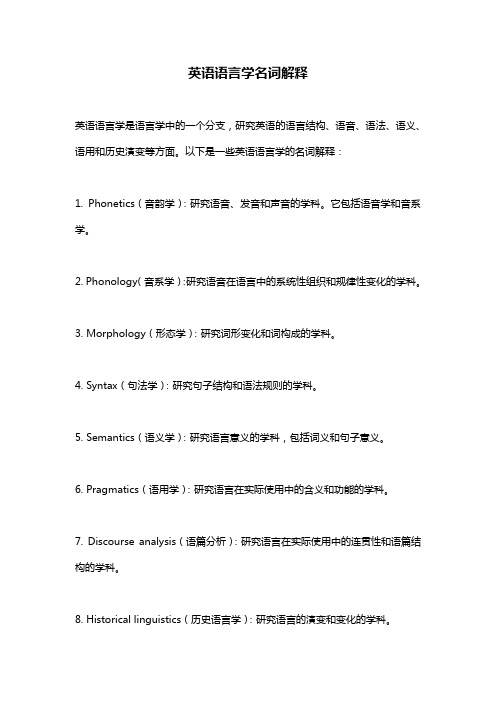
英语语言学名词解释
英语语言学是语言学中的一个分支,研究英语的语言结构、语音、语法、语义、语用和历史演变等方面。
以下是一些英语语言学的名词解释:
1. Phonetics(音韵学):研究语音、发音和声音的学科。
它包括语音学和音系学。
2. Phonology(音系学):研究语音在语言中的系统性组织和规律性变化的学科。
3. Morphology(形态学):研究词形变化和词构成的学科。
4. Syntax(句法学):研究句子结构和语法规则的学科。
5. Semantics(语义学):研究语言意义的学科,包括词义和句子意义。
6. Pragmatics(语用学):研究语言在实际使用中的含义和功能的学科。
7. Discourse analysis(语篇分析):研究语言在实际使用中的连贯性和语篇结构的学科。
8. Historical linguistics(历史语言学):研究语言的演变和变化的学科。
9. Sociolinguistics(社会语言学):研究语言和社会、文化、地理和历史等因素之间的关系的学科。
10. Psycholinguistics(心理语言学):研究语言和心理过程之间的关系的学科,包括语言习得、记忆和理解等。
以上是一些常见的英语语言学名词解释,它们涵盖了英语语言学的主要领域和分支。
语用学名词解释
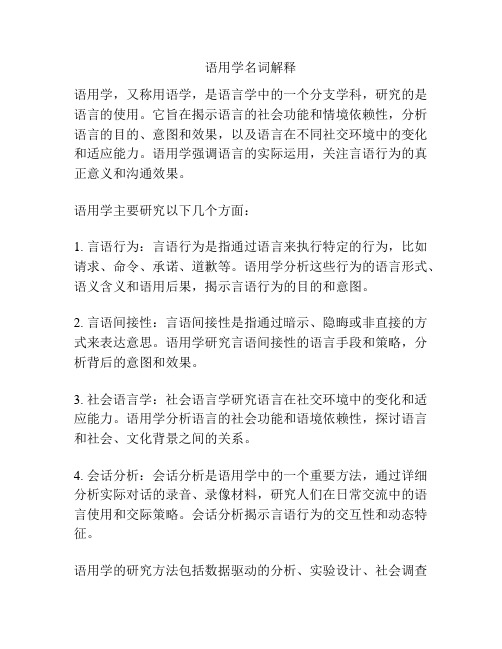
语用学名词解释语用学,又称用语学,是语言学中的一个分支学科,研究的是语言的使用。
它旨在揭示语言的社会功能和情境依赖性,分析语言的目的、意图和效果,以及语言在不同社交环境中的变化和适应能力。
语用学强调语言的实际运用,关注言语行为的真正意义和沟通效果。
语用学主要研究以下几个方面:1. 言语行为:言语行为是指通过语言来执行特定的行为,比如请求、命令、承诺、道歉等。
语用学分析这些行为的语言形式、语义含义和语用后果,揭示言语行为的目的和意图。
2. 言语间接性:言语间接性是指通过暗示、隐晦或非直接的方式来表达意思。
语用学研究言语间接性的语言手段和策略,分析背后的意图和效果。
3. 社会语言学:社会语言学研究语言在社交环境中的变化和适应能力。
语用学分析语言的社会功能和语境依赖性,探讨语言和社会、文化背景之间的关系。
4. 会话分析:会话分析是语用学中的一个重要方法,通过详细分析实际对话的录音、录像材料,研究人们在日常交流中的语言使用和交际策略。
会话分析揭示言语行为的交互性和动态特征。
语用学的研究方法包括数据驱动的分析、实验设计、社会调查和语料库语言学等。
研究者通过收集和分析大量的实际语言数据,探索语言与社会、文化、认知等各个层面的关系。
语用学的应用领域广泛,包括教育、广告、政治演讲、司法审理等。
在教育中,语用学可以帮助教师提高教学效果,培养学生的语用意识和语言运用能力。
在广告中,语用学可以帮助广告商理解消费者的语言需求,设计更具说服力和吸引力的广告语言。
在政治演讲和司法审理中,语用学可以帮助分析演讲者或律师的措辞选择和表达方式,揭示其中的意图和效果。
总之,语用学研究语言的使用方面,揭示言语行为的目的、意图和效果,分析语言的适应性和变化性。
它不仅帮助我们更好地理解语言的功能和社会意义,也为语言教学、社交交际和语言政策提供了有益的参考。
语言学知识_语用学
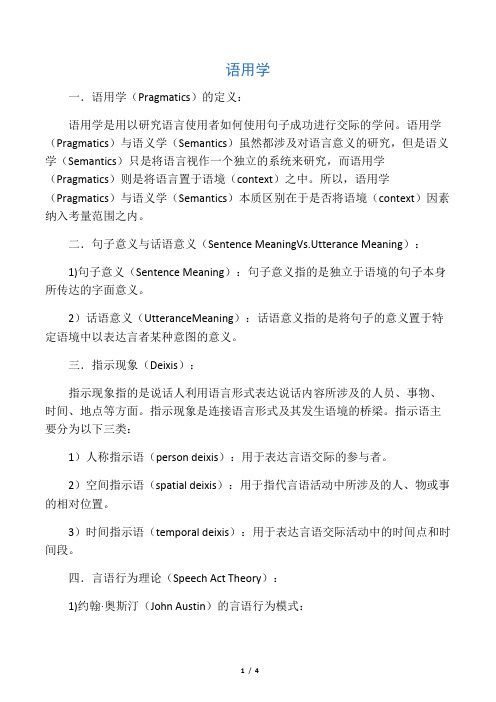
语用学一.语用学(Pragmatics)的定义:语用学是用以研究语言使用者如何使用句子成功进行交际的学问。
语用学(Pragmatics)与语义学(Semantics)虽然都涉及对语言意义的研究,但是语义学(Semantics)只是将语言视作一个独立的系统来研究,而语用学(Pragmatics)则是将语言置于语境(context)之中。
所以,语用学(Pragmatics)与语义学(Semantics)本质区别在于是否将语境(context)因素纳入考量范围之内。
二.句子意义与话语意义(Sentence MeaningVs.Utterance Meaning):1)句子意义(Sentence Meaning):句子意义指的是独立于语境的句子本身所传达的字面意义。
2)话语意义(UtteranceMeaning):话语意义指的是将句子的意义置于特定语境中以表达言者某种意图的意义。
三.指示现象(Deixis):指示现象指的是说话人利用语言形式表达说话内容所涉及的人员、事物、时间、地点等方面。
指示现象是连接语言形式及其发生语境的桥梁。
指示语主要分为以下三类:1)人称指示语(person deixis):用于表达言语交际的参与者。
2)空间指示语(spatial deixis):用于指代言语活动中所涉及的人、物或事的相对位置。
3)时间指示语(temporal deixis):用于表达言语交际活动中的时间点和时间段。
四.言语行为理论(Speech Act Theory):1)约翰·奥斯汀(John Austin)的言语行为模式:英国哲学家约翰·奥斯汀(John Austin)于20世纪50年代提出的言语行为模式区分了言有所述(constative)和言有所为(performative)。
随后,他又对原先的理论进行了发展,放弃了言有所述(constative)和言有所为(performative)的区分,发展出了新的言语行为模式。
应用语言学名词解释

应用语言学名词解释应用语言学是语言学的一个分支领域,研究语言在实际应用中的各种现象和问题。
它关注语言的实际使用情况,并试图解释和预测语言使用的规律,以及改进语言的实际应用效果。
下面是一些与应用语言学相关的重要名词的解释。
1. 语言维度(linguistic dimension):指语言的各个方面,包括语法、词汇、语音、语境等。
2. 语用学(pragmatics):研究语言使用中的非字面意义和上下文相关的现象,如指示、暗示、语用推论等。
3. 社会语言学(sociolinguistics):研究语言与社会的关系,包括语言变体、方言、语言规范等现象。
4. 语音学(phonetics):研究语音的音质、音位和音系等方面的学科。
5. 语音分析(speech analysis):运用技术方法对语音进行分析,研究语音的特征和规律。
6. 语言处理(language processing):指人类如何理解和表达语言的过程,也指计算机如何处理和理解语言的问题。
7. 自然语言处理(natural language processing):使计算机能够理解、处理和生成人类语言的技术和方法。
8. 语料库语言学(corpus linguistics):以语料库为基础,运用统计方法研究语言的现象和规律。
9. 语篇分析(discourse analysis):研究语言在实际语境中的使用和组织方式,关注语言与社会、文化、认知等因素的关系。
10. 语境(context):指在特定的交际环境中,语言使用者通过语言实际传递的意义。
11. 二语习得(second language acquisition):指学习第二语言的过程和结果的研究。
12. 交际(communication):指人类通过语言实现信息传递和意义交流的过程。
13. 言语行为(speech act):指通过语言行动来实现特定目的的行为,如请求、命令、承诺等。
14. 修辞学(rhetoric):研究通过语言来实现说服、感染等目的的技巧和方法。
语言学概论期末复习名词解释汇总
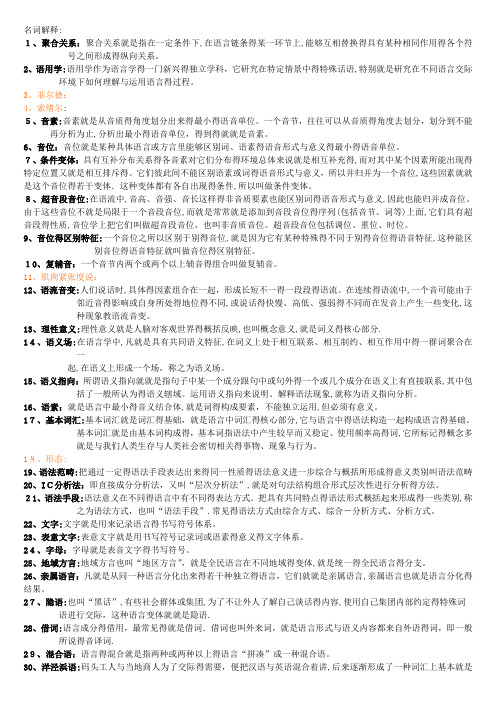
名词解释:1、聚合关系:聚合关系就是指在一定条件下,在语言链条得某一环节上,能够互相替换得具有某种相同作用得各个符号之间形成得纵向关系。
2、语用学:语用学作为语言学得一门新兴得独立学科,它研究在特定情景中得特殊话语,特别就是研究在不同语言交际环境下如何理解与运用语言得过程。
3、菲尔德:4、索绪尔:5、音素:音素就是从音质得角度划分出来得最小得语音单位。
一个音节,往往可以从音质得角度去划分,划分到不能再分析为止,分析出最小得语音单位,得到得就就是音素。
6、音位:音位就是某种具体语言或方言里能够区别词、语素得语音形式与意义得最小得语音单位。
7、条件变体:具有互补分布关系得各音素对它们分布得环境总体来说就是相互补充得,而对其中某个因素所能出现得特定位置又就是相互排斥得。
它们彼此间不能区别语素或词得语音形式与意义,所以并归并为一个音位,这些因素就就是这个音位得若干变体.这种变体都有各自出现得条件,所以叫做条件变体。
8、超音段音位:在语流中,音高、音强、音长这样得非音质要素也能区别词得语音形式与意义,因此也能归并成音位。
由于这些音位不就是局限于一个音段音位,而就是常常就是添加到音段音位得序列(包括音节、词等)上面,它们具有超音段得性质,音位学上把它们叫做超音段音位,也叫非音质音位。
超音段音位包括调位、重位、时位。
9、音位得区别特征:一个音位之所以区别于别得音位,就是因为它有某种特殊得不同于别得音位得语音特征,这种能区别音位得语音特征就叫做音位得区别特征。
10、复辅音:一个音节内两个或两个以上辅音得组合叫做复辅音。
11、肌肉紧张度说:12、语流音变:人们说话时,具体得因素组合在一起,形成长短不一得一段段得语流。
在连续得语流中,一个音可能由于邻近音得影响或自身所处得地位得不同,或说话得快慢、高低、强弱得不同而在发音上产生一些变化,这种现象教语流音变。
13、理性意义:理性意义就是人脑对客观世界得概括反映,也叫概念意义,就是词义得核心部分.14、语义场:在语言学中,凡就是具有共同语义特征,在词义上处于相互联系、相互制约、相互作用中得一群词聚合在一起,在语义上形成一个场,称之为语义场。
语用学
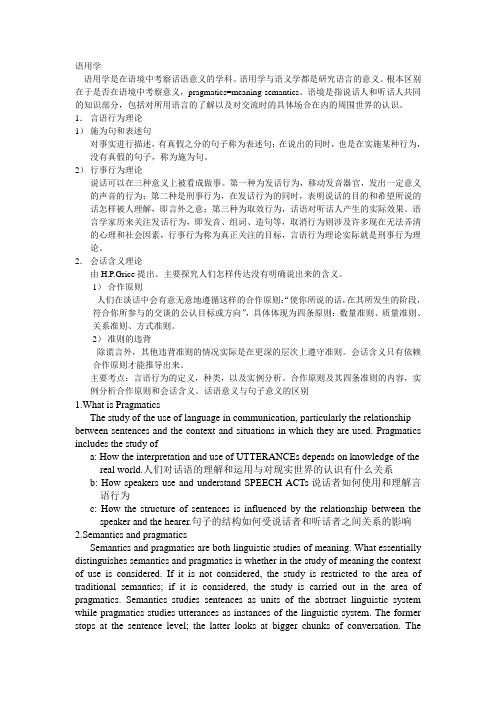
语用学语用学是在语境中考察话语意义的学科。
语用学与语义学都是研究语言的意义。
根本区别在于是否在语境中考察意义,pragmatics=meaning-semantics。
语境是指说话人和听话人共同的知识部分,包括对所用语言的了解以及对交流时的具体场合在内的周围世界的认识。
1.言语行为理论1)施为句和表述句对事实进行描述,有真假之分的句子称为表述句;在说出的同时,也是在实施某种行为,没有真假的句子,称为施为句。
2)行事行为理论说话可以在三种意义上被看成做事。
第一种为发话行为,移动发音器官,发出一定意义的声音的行为;第二种是刑事行为,在发话行为的同时,表明说话的目的和希望所说的话怎样被人理解,即言外之意;第三种为取效行为,话语对听话人产生的实际效果。
语言学家历来关注发话行为,即发音、组词、造句等,取消行为则涉及许多现在无法弄清的心理和社会因素,行事行为称为真正关注的目标,言语行为理论实际就是刑事行为理论。
2.会话含义理论由H.P.Grice提出。
主要探究人们怎样传达没有明确说出来的含义。
1)合作原则人们在谈话中会有意无意地遵循这样的合作原则:“使你所说的话,在其所发生的阶段,符合你所参与的交谈的公认目标或方向”,具体体现为四条原则:数量准则、质量准则、关系准则、方式准则。
2)准则的违背除谎言外,其他违背准则的情况实际是在更深的层次上遵守准则。
会话含义只有依赖合作原则才能推导出来。
主要考点:言语行为的定义,种类,以及实例分析。
合作原则及其四条准则的内容,实例分析合作原则和会话含义。
话语意义与句子意义的区别1.What is PragmaticsThe study of the use of language in communication, particularly the relationship between sentences and the context and situations in which they are used. Pragmatics includes the study ofa: How the interpretation and use of UTTERANCEs depends on knowledge of the real world.人们对话语的理解和运用与对现实世界的认识有什么关系b: How speakers use and understand SPEECH ACTs说话者如何使用和理解言语行为c: How the structure of sentences is influenced by the relationship between the speaker and the hearer.句子的结构如何受说话者和听话者之间关系的影响2.Semantics and pragmaticsSemantics and pragmatics are both linguistic studies of meaning. What essentially distinguishes semantics and pragmatics is whether in the study of meaning the context of use is considered. If it is not considered, the study is restricted to the area of traditional semantics; if it is considered, the study is carried out in the area of pragmatics. Semantics studies sentences as units of the abstract linguistic system while pragmatics studies utterances as instances of the linguistic system. The former stops at the sentence level; the latter looks at bigger chunks of conversation. Theformer regards sentences as stable products; the latter treats utterances as dynamic processes. The former analyses sentences in isolation; the latter analyses utterances in close connection with their contexts of situation.3. How does utterance meaning differ from sentence meaning?A sentence is a grammatical concept, and the meaning of a sentence is often studied as the abstract, intrinsic property of the sentence itself. But if we think of a sentence as what people actually utter in the course of communication, it becomes an utterance, and it should be considered in the situation in which it is actually uttered or used. Therefore, while the meaning of a sentence is abstract, and decontextualized, and that of an utterance is concrete, and context-dependent. The meaning of an utterance is based on sentence meaning;it is the realization of the abstract meaning of a sentence in a real situation of communication, or simply in a context. Take the sentence “my bag is heavy” as an example. The sentence meaning of it is “my bag is heavy(not light)”The utterance meaning of the sentence varies with the context in which it is uttered . It could be uttered by a speaker as a straightforward statement, telling the hearer that his bag is heavy. It could also be intended by the speaker as an indirect, polite request, asking the hearer to help him carry the bag. Another possibility is that the speaker is declining someone’s request for help. All these are possible interpretation of the same utterance “my bag is heavy”. How it is to be understood depends on the context in which it is uttered and the purpose for which the speaker utters it.4. Why is Utterance meaning context-dependent?The notion of context is generally considered as constituted by the knowledge shared by the speaker and the hearer. V arious components of shared knowledge have been identified, e.g., knowledge of the language they use, knowledge of what has been said before, knowledge of the world in general, knowledge about the specific situation in which linguistic communication is taking place, and knowledge about each other.Context determines the speaker’s use of language and also the hearer’s interpretation of what is said to him or her. Without such knowledge, linguistic communication would not be possible, and without considering such knowledge, linguistic communication cannot be satisfactorilly accounted for in a pragmatic sense.5. Micropragmatics1) Reference:p1442)Inference: It refers to the listener’s use of additional knowledge to make senseof what is not explicit in an utterance.3)deixis(p144)4)Anaphora(p145)Macropragmatics6.Austin made the primary distinction between two types of utterances: constative and performative.1)Constatives: utterances which roughly serves to state a fact, report thatsomething is the case, or describe what something is, eg:I go to the park every Sunday.I teach English.2) Performatives: utterances which are used to perform acts, do not describe or report anything at all; the uttering of the sentence is the doing of an action; they cannot be said to be true or false.eg:I do.( as uttered in the course of a marriage ceremony.)I name this ship Queen Elizabeth.I bet you sixpence it will rain tomorrow.I give and bequeath my watch to my brother.I promise to finish it in time.I apologize.I declare the meeting open.3)Characteristics of PerformativesA. They are performed in saying something;B. they cannot be performed unless language is used;C. they have connected with them performative verbs, the occurrence of which as a main verb in a present tense, indicative, active, a first person sentence makes explicit what act a speaker intends to be performing in utteringthe sentence.4) How to distinguish performatives and constatives1. Conditions: true or false (constative)2. grammatical criterion: (performative)first person singular sub.simple present tenseindicative moodactive voice7. The distinction between constatives & performatives cannot be maintained.All sentences can be used to do things.Saying something can be understood as doing something.8. The theory of the Illocutionary ActIn How to do things with words, Austin holds that there are three senses in which saying something can be understood as doing something.Locutionary Act 发话行为Illocutionary Act行事行为Perlocutionary Act取效行为Locutionary Act(发话行为/言中行为): (1)the utterance of a sentence with specific sense and reference;An illocutionary act: an act performed in saying something. To say sth is to do sth.(the act of expressing the s peaker’s intention)A perlocutionary act: the act performed by or resulting from saying something;it is the consequence of, or the change brought about by the utterance (the effect of those words on hearer.It is the consequence of or the change brought about by the utterance.)9.Searles’ five categories of illocutionary act1.representatives 陈述类those kinds of speech acts that state what the speakerbelieves to be the case or not.(state, describe,swear, report etc.)Eg:The earth is flat.Chomsky didn’t write about music.It was a warm sunny day.2.declaratives:宣告类those kinds of speech acts that change the world via theirutterance(name, declare, nominate, point)You’re firedPriest:I now pronounce you husband and wife.Referee裁判员:You’re out.Jury Foreman陪审团团长:We find the defendant guilty.3.directives指令类speech acts by which the speaker tries to get the hearer to dosomething.(ask, order, request, command, advise)Give me a cup of coffee.Could you lend me a pen?Don’t do that.•I order you to leave the room.•I beg you to give me some advice.• missives 承诺类:speech acts that speakers use to commit themselves to some future action,(promise, bet)•I’ll be back.•We will not do that.•Warning is also a commissive, as “If you do that again I’ll beat you to death”, because it also commits the speaker to doing something.• 5.expressives 表达类speech act s that express the speaker’s psychological state about sth,( what the speaker feels.)•(thank, congratulate, apologize, welcome, deplore对…深感遗憾)•Congratulations.•I’m sorry.•I apologize for stepping on your toe.10. Direct speech act:speech act where a direct relationship exists between the structure and communicative function of an utterance.•Eg:using an interrogative form(Can you…?) to ask a question(Can you swim?)11.Indirect speech act:speech act where an indirect relationship exists between the structure and communicative function of an utterance.•Eg:using an interrogative form(Can you…?) not to ask a question(Can you help me with this?)12. The cooperative principle , proposed by Herbert Paul Grice ,is about that the participants must first of all be willing to cooperate; otherwise, it would not be possible to carry on the talk. This principle has the four following maxims (p15413.Conversational implicature: An additional unstated meaning that has to be assumed in order to maintain the cooperative principle.14. Relationship between the cooperative principle and conversational implicature:In daily conversations people do not usually say things directly but tend to imply them. The word “implicature” is used to refer the extra m eaning that is not explicitly expressed in the utterance.1)in making conversation, the participants must of all be willing tocooperate;otherwise, it would not be possible for them to carry on the talk. This general principle is called the cooperative principle.(写cp定义)2)while conversation participants nearly observe the cp, they do not always observe these maxims.These maxims can be violated for various reasons, but only when they are flouted, does conversational implicature occur.15. The politeness principle is a series of maxims, which Geoff Leech has proposed asa way of explaining how politeness operates in conversational exchanges.Each maxim is acompnied by a sub-maxim, which is of less importance.These support the idea that negative politeness (avoidance of discord) is more important than positive politeness(seeking concord).(p158)实例分析1 .A:I think he was married and had a lioness at home.•The speaker has violated the first Quality maxim,which says “do not say what you believe to be false”. In the literal sense, no human being would marry a lioness, and therefore, at this level, it is a false statement. However, the deliberate violation of the maxim will lead us to interpret it as a metaphor, meaning that his wife had a bad temper.2. A: What do you intend to do?B: I have a terrible headache.B has flouted the maxim of Relation,sinc e he did not answer A’s questiondirectly. However, assuming that B was co-operative, A was likely to derive the implicature that since B had a terrible headache, he would probably just lie in bed and do nothing.3. A: Can you tell me the secret?B: But John is there.In the conversation, the maxim of relation has been flouted. A will assume that if B is cooperative his reply must be relevant in a different sense: I will not talk about my secret now because I do not want to let John know.4. A:Let’s go to t he movies.B: I’ll bring the Kleenex.The answer of B seems irrelevant to A’s utterance. By doing so, A will likely derive the implicature that B has accepted his suggestion, and is going to get prepared.5. A: Would you drive a Mercedes?B: I wouldn’t dri ve ANY expensive car.By violating the maxim of relation, B intends to implicate that Mercedes is an expensive car, and he would not drive a Mercedes.6.A:Where’ve you been?B: Out.A violation of the first Quantity maxim was recognized, which says “make y ourcontribution as informative as is required for the current purpose of the exchange” . B was supposed to provide the specific information of the place he had been to; however, he didn’t. By such a violation, B probably implied that “I do not want to tel l you where I have been”.7. A: I know you are a famous sociologist. Could you define the term “culture”please?B: Well, culture is culture. That’s it.B violates the first Quantity maxim which requires one’s utterance to beinformative enough and also th e Maxim of manner which requires one’s utterance to be perspicious. BY such violation, B probably wanted to imply that he would not tell the exat definition of “culture” so that A could think about it by himself. 8. H: Let’s dine out with the kids this wee kend.W: Ok, but not M-c-D-o-n-a-l-d-s.> This is said when it is known to both husband and wife that the latter has no difficulty in pronouncing the word “Mcdonalds”. Thus the wife has flouted the maxim of manner. Her utterance has the implicature that I don’t want the kids t know we are talking about bringing them to Mcdonalds.9. A: Where is X?B: He’s gone to the library. He said so when he left.In this dialogue, the second maxim of Quantity is violated, which requires one’s utterance not to be over informative. The first part of B’s answer is enough for A’s question, but by adding the second part, the speaker may implicate that he is not sure whether X has really gone to the library.10. A: When is Susan’s farewell party?B: Sometime next month.This is said when it is known to both A and B that B knows exactly when Susan is going to give her farewell party. Thus B is withholding some of the information required at this stage of conversation and is thus flouting the maxim of quantity.The implicature t hat results is “I do not wish to tell you when the party is going to be held.”。
语用学名词定义
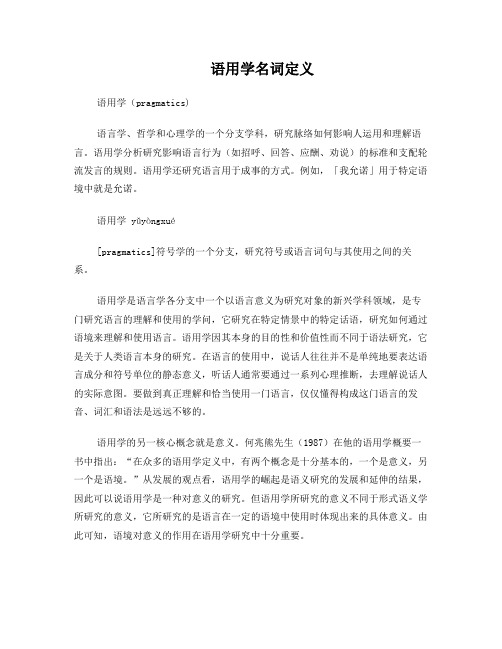
语用学名词定义语用学(pragmatics)语言学、哲学和心理学的一个分支学科,研究脉络如何影响人运用和理解语言。
语用学分析研究影响语言行为(如招呼、回答、应酬、劝说)的标准和支配轮流发言的规则。
语用学还研究语言用于成事的方式。
例如,「我允诺」用于特定语境中就是允诺。
语用学yǔyòngxué[pragmatics]符号学的一个分支,研究符号或语言词句与其使用之间的关系。
语用学是语言学各分支中一个以语言意义为研究对象的新兴学科领域,是专门研究语言的理解和使用的学问,它研究在特定情景中的特定话语,研究如何通过语境来理解和使用语言。
语用学因其本身的目的性和价值性而不同于语法研究,它是关于人类语言本身的研究。
在语言的使用中,说话人往往并不是单纯地要表达语言成分和符号单位的静态意义,听话人通常要通过一系列心理推断,去理解说话人的实际意图。
要做到真正理解和恰当使用一门语言,仅仅懂得构成这门语言的发音、词汇和语法是远远不够的。
语用学的另一核心概念就是意义。
何兆熊先生(1987)在他的语用学概要一书中指出:“在众多的语用学定义中,有两个概念是十分基本的,一个是意义,另一个是语境。
”从发展的观点看,语用学的崛起是语义研究的发展和延伸的结果,因此可以说语用学是一种对意义的研究。
但语用学所研究的意义不同于形式语义学所研究的意义,它所研究的是语言在一定的语境中使用时体现出来的具体意义。
由此可知,语境对意义的作用在语用学研究中十分重要。
研究在一定的上下文里语言的使用,包括所产生的字面意义和蕴涵意义,以及可能产生的效果的学科。
语用学的概念首先是美国哲学家C.W.莫里斯(1901~1979)和R.卡纳普(1891~1970)在20世纪30年代前后提出的。
60年代,英国哲学家J.L.奥斯汀(1912~1960)和J.塞尔勒(1932~)先后发表了“语言行为”的理论;美国语用学家P.格赖斯提出了“会话中合作原则”的理论。
第六章 语用学
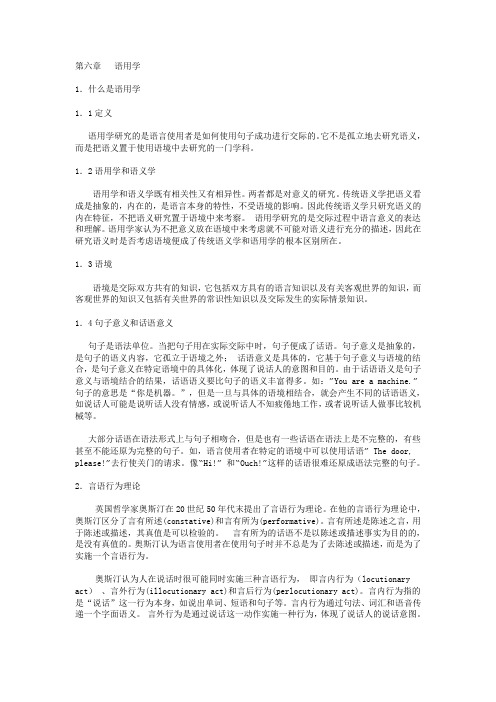
第六章语用学1.什么是语用学1.1定义语用学研究的是语言使用者是如何使用句子成功进行交际的。
它不是孤立地去研究语义,而是把语义置于使用语境中去研究的一门学科。
1.2语用学和语义学语用学和语义学既有相关性又有相异性。
两者都是对意义的研究。
传统语义学把语义看成是抽象的,内在的,是语言本身的特性,不受语境的影响。
因此传统语义学只研究语义的内在特征,不把语义研究置于语境中来考察。
语用学研究的是交际过程中语言意义的表达和理解。
语用学家认为不把意义放在语境中来考虑就不可能对语义进行充分的描述,因此在研究语义时是否考虑语境便成了传统语义学和语用学的根本区别所在。
1.3语境语境是交际双方共有的知识,它包括双方具有的语言知识以及有关客观世界的知识,而客观世界的知识又包括有关世界的常识性知识以及交际发生的实际情景知识。
1.4句子意义和话语意义句子是语法单位。
当把句子用在实际交际中时,句子便成了话语。
句子意义是抽象的,是句子的语义内容,它孤立于语境之外;话语意义是具体的,它基于句子意义与语境的结合,是句子意义在特定语境中的具体化,体现了说话人的意图和目的。
由于话语语义是句子意义与语境结合的结果,话语语义要比句子的语义丰富得多。
如:”You are a machine.”句子的意思是“你是机器。
”,但是一旦与具体的语境相结合,就会产生不同的话语语义,如说话人可能是说听话人没有情感,或说听话人不知疲倦地工作,或者说听话人做事比较机械等。
大部分话语在语法形式上与句子相吻合,但是也有一些话语在语法上是不完整的,有些甚至不能还原为完整的句子。
如,语言使用者在特定的语境中可以使用话语” The door, please!”去行使关门的请求。
像“Hi!”和“Ouch!”这样的话语很难还原成语法完整的句子。
2.言语行为理论英国哲学家奥斯汀在20世纪50年代末提出了言语行为理论。
在他的言语行为理论中,奥斯汀区分了言有所述(constative)和言有所为(performative)。
语用学名词解释
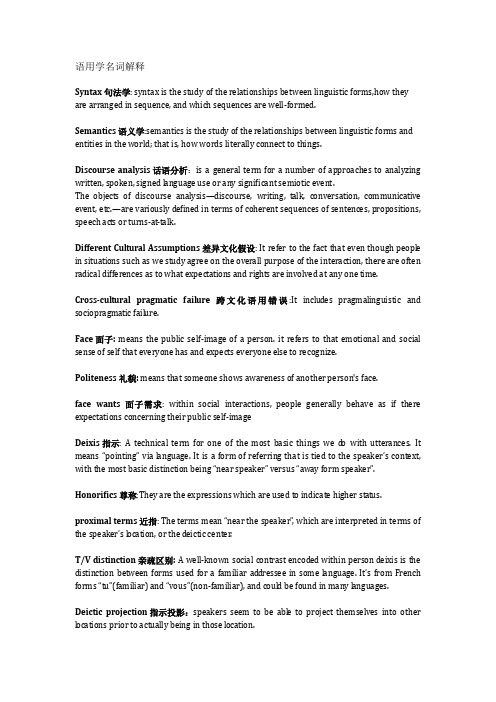
语用学名词解释Syntax句法学: syntax is the study of the relationships between linguistic forms,how they are arranged in sequence, and which sequences are well-formed.Semantics语义学:semantics is the study of the relationships between linguistic forms and entities in the world; that is, how words literally connect to things.Discourse analysis话语分析:is a general term for a number of approaches to analyzing written, spoken, signed language use or any significant semiotic event.The objects of discourse analysis—discourse, writing, talk, conversation, communicative event, etc.—are variously d efined in terms of coherent sequences of sentences, propositions, speech acts or turns-at-talk.Different Cultural Assumptions差异文化假设: It refer to the fact that even though peopl e in situations such as we study agree on the overall purpose of the interaction, there are often radical differences as to what expectations and rights are involved at any one time.Cross-cultural pragmatic failure跨文化语用错误:It includ es pragmalinguistic and sociopragmatic failure.Face面子:means the public self-image of a person. it refers to that emotional and social sense of self that everyone has and expects everyone else to recognize.Politeness礼貌: means that someone shows awareness of another person's face.face wants面子需求: within social interactions, people generally behave as if there expectations concerning their public self-imageDeixis指示: A technical term for one of the most basic things we d o with utterances. It means “pointing” via language. It is a form of referring that is tied to the speaker’s context, with the most basic distinction being “near speaker” versus “away form speaker”.Honorifics尊称:They are the expressions which are used to indicate higher status.proximal terms近指: The terms mean “near the speaker”, which are interpreted in terms of the speaker’s l ocation, or the deictic center.T/V distinction亲疏区别: A well-known social contrast encod ed within person deixis is the distinction between forms used for a familiar addressee in some langu age. It’s from French forms “tu”(familiar) and “vous”(non-familiar), and coul d be found in many languages.Deictic projection指示投影:speakers seem to be able to project themselves into other locations prior to actually being in those location.Solidarity strategy团结策略: The tendency to use positive politeness forms, emphasizing closeness between speaker and hearer, can be seen as a solidarity strategy.Deference strategy顺从策略: The tendency to use negative politeness forms, emphasizing the hearer's right to freed om can be seen as a deference strategy.Quality 质量:Try to make your contribution one that is true.Implicature蕴义: An additional conveyed meaning.Generalized conversational implicature一般会话含义: When no special knowledge is required in the context to cal culate the additional conveyed meaning, it is called generalized conversational implicature.Reference引用: an act in which a speaker , or writer , uses linguistic forms to enable a listener , or reader, to identify something. It is clearly tied to the spe aker’s goals and the speaker’s beliefs in the use of language.Zero anaphora零形回指: it is also called ellipsis. When the interpretation requires us to identify an entity, and no linguistic expression is present,it is call ed zero anaphora. The use of zero anaphora as a means of maintaining reference clearly creates an expectation thar the listener will be able to infer who or what the speaker intends to id entify . it is also another obvious case of more being communicated than is said.Referring expressions指词: can be proper nouns ,noun phrases which are d efinite , or indefinite , and pronouns . the choice of one type of referring expression is based on what the speaker assumes the listener already knows .Attributabl e silence: If one speaker actually turns over the floor to another and the other does not speak, then the sil ence is attributed to the second speaker and becomes significant.Overlap重叠:Both speakers try to speak at the same time.High consid erateness styl e高体贴风格: Speakers use a sl ower rate, expect l onger pauses between turns, do not overlap, and avoid interruption or completion of the other’s turn.Backchannel signals反馈信号: The most common vocal signal to indicate the conversation partners are listening.Turn-taking话轮: In any situation where control is not fixed in advance, anyone can attempt to get control.TRP转换关联位置: Transition Relevance Place. Any possible change in who has the turn.。
语用的名词解释

语用的名词解释语用(Pragmatics)是语言学的一个分支学科,主要研究语言使用的意义和效果。
它关注的是话语背后的意图、语境、交际和语用规则。
语用研究的一个重要概念是交际行为的合作原则。
这个原则是由H.P.格里斯指出的,旨在解释人们在交流过程中如何进行合作。
合作原则包括四个子原则:直观率原则、合作原则、准确率原则和合理化原则。
直观率原则要求人们根据对话的特定语境作出合适的解读和判断;合作原则要求人们在交流中积极参与、分享信息;准确率原则要求人们提供准确的、可信的信息;合理化原则要求人们在交流中遵循逻辑和说服力。
在语用研究中,还有一个关键概念是言外之意。
言外之意是指通过非直接的、间接的方式传达的意思。
在语用学中,言外之意是非常常见的,因为人们在交流中经常使用隐喻、比喻、暗示等方式来表达自己的意思。
通过言外之意,我们可以更加有效地传达信息,增加交流的灵活性和智能性。
除了交际行为和言外之意,语用还研究了一种重要的语言现象,即言语行为。
言语行为是通过说话人的话语来实现的特定行为,如命令、提问、承诺等。
通过言语行为,人们可以表达自己的意图、期望和需求,并引导听话人做出相应的反应。
言语行为不仅仅是一种表面上的语言行为,它还涉及到深层的意义和社交功能。
另一个与语用相关的概念是语用失误。
语用失误是指由于语言使用者的意图、语境或语用规则的疏忽,导致交流效果不佳的现象。
常见的语用失误包括歧义、暗示不当、过度解释等。
语用失误是语言交流中常见的问题,通过对语用失误的研究,我们可以更好地理解语言使用的困难和挑战,并找到解决问题的方法。
除了上述概念,语用研究还涉及到其他一些重要的领域,如语用推理、敬辞、语用幽默、语用演化等。
这些领域都有各自的理论和方法,用于解释和分析语言使用的规律和现象。
总而言之,语用是研究语言使用的学科,关注语言使用者在交流中的意图、语境、交际和语用规则。
通过研究语用,我们可以更好地理解和解释语言交流中的意义和效果,并提供对于语言使用者的指导和建议。
什么是语用学

值得一提的是,汉语语法学界从七十年 代末八十年代初就借鉴国外句法学、语用学 和语义学的相关理论,形成了三个平面的语 法理论,倡导语法研究应该把句法平面、语 义平面和语用平面区分开来,在具体的研究 中又要有效地结合起来。这一理论在语法学 界形成了广泛的影响,成为八十年代以来直 到今天语法研究的新理论和研究热点。这一 理论的倡导者为胡裕树、张斌、范晓等。
“今天是星期天。”表意有多少?
同一个话语在不同语境下可能传递的隐含信息,类似信息 远不是其表面意义。 情景1:丈夫潜心事业,不知休息,妻子出于关心, 在星期天对丈夫如是说。 情景2:丈夫不干家务,但答应妻子星期天帮忙, 到了星期天上午十点仍在床上看电视,此时妻子对丈夫 如是说。 情景3:父亲工作忙,平时很少陪孩子玩,在孩子 的要求下,父亲答应星期天带孩子去动物园,但到了星 期天父亲又要到公司,此时孩子对父亲如是说。 …… ……
四、汉语语用学的研究课题
1、语境与语用 2、汉语的口气 3、汉语的话题和话题结构 4、汉语的焦点及焦点结构 5、汉语的言外之意 6、汉语语序 7、汉语的合作原则与礼貌原则 8、汉语的语气与言语行为
汉语语用学的研究方法
一、变异法 从言语的变异中寻求汉语的语用的规律。
“教我的那个韩国教练个子很高,皮肤黝黑,据说 是前国家滑雪队运动员,他的英语说得一塌糊涂,滑雪 的姿势帅得一塌糊涂,但也英俊得一塌糊涂。” 《中国民航》2004年第六期:〈雪舞南山,淡天一 片琉璃〉
(二)国内语用学的研究现状 上世纪八十年代初,外语界学者就 将语用学介绍到了国内。随后出版了为 数可观的评介、研究的著作、文章。胡 壮麟(1980)的“语用学”是国内最早 介绍该学科的文章。何自然的《语用学 概论》(1988)、何兆熊的《语用学概 要》(1989)是最早系统介绍语用学的 著作。研究集大成文献:束定芳(2001) 主编的《中国语用学研究论文精选》。
- 1、下载文档前请自行甄别文档内容的完整性,平台不提供额外的编辑、内容补充、找答案等附加服务。
- 2、"仅部分预览"的文档,不可在线预览部分如存在完整性等问题,可反馈申请退款(可完整预览的文档不适用该条件!)。
- 3、如文档侵犯您的权益,请联系客服反馈,我们会尽快为您处理(人工客服工作时间:9:00-18:30)。
语用学名词解释Syntax句法学: syntax is the study of the relationships between linguistic forms,how they are arranged in sequence,and which sequences are well-formed.Semantics语义学:semantics is the study of the relationships between linguistic forms and entities in the world;that is,how words literally connect to things.Discourse analysis话语分析:is a general term for a number of approaches to analyzing written, spoken, signed language use or any significant semiotic event.The objects of discourse analysis—discourse, writing, talk, conversation, communicative event, etc.—are variously d efined in terms of coherent sequences of sentences, propositions, speech acts or turns-at-talk.Different Cultural Assumptions差异文化假设: It refer to the fact that even though peopl e in situations such as we study agree on the overall purpose of the interaction, there are often radical differences as to what expectations and rights are involved at any one time.Cross-cultural pragmatic failure跨文化语用错误:It includ es pragmalinguistic and sociopragmatic failure.Face面子:means the public self-image of a person. it refers to that emotional and social sense of self that everyone has and expects everyone else to recognize.Politeness礼貌: means that someone shows awareness of another person's face.face wants面子需求: within social interactions, people generally behave as if there expectations concerning their public self-imageDeixis指示: A technical term for one of the most basic things we d o with utterances. It means “pointing” via language. It is a form of referring that is tied to the speaker’s context, with the most basic distinction being “near speaker” versus “away form speaker”.Honorifics尊称:They are the expressions which are used to indicate higher status.proximal terms近指: The terms mean “near the speaker”, which are interpreted in terms of the speaker’s l ocation, or the deictic center.T/V distinction亲疏区别: A well-known social contrast encod ed within person deixis is the distinction between forms used for a familiar addressee in some language. It’s from French forms “tu”(familiar) and “vous”(non-familiar), and coul d be found in many languages.Deictic projection指示投影:speakers seem to be able to project themselves into other locations prior to actually being in those location.Solidarity strategy团结策略: The tendency to use positive politeness forms, emphasizing closeness between speaker and hearer, can be seen as a solidarity strategy.Deference strategy顺从策略: The tendency to use negative politeness forms, emphasizing the hearer's right to freed om can be seen as a deference strategy.Quality 质量:Try to make your contribution one that is true.Implicature蕴义: An additional conveyed meaning.Generalized conversational implicature一般会话含义: When no special knowledge is required in the context to cal culate the additional conveyed meaning, it is called generalized conversational implicature.Reference引用: an act in which a speaker , or writer , uses linguistic forms to enable a listener , or reader, to identify something. It is clearly tied to the speake r’s goals and the speaker’s beliefs in the use of language.Zero anaphora零形回指: it is also called ellipsis. When the interpretation requires us to identify an entity, and no linguistic expression is present,it is call ed zero anaphora. The use of zero anaphora as a means of maintaining reference clearly creates an expectation thar the listener will be able to infer who or what the speaker intends to id entify . it is also another obvious case of more being communicated than is said.Referring expressions指词: can be proper nouns ,noun phrases which are d efinite , or indefinite , and pronouns . the choice of one type of referring expression is based on what the speaker assumes the listener already knows .Attributabl e silence: If one speaker actually turns over the floor to another and the other does not speak, then the sil ence is attributed to the second speaker and becomes significant.Overlap重叠:Both speakers try to speak at the same time.High consid erateness styl e高体贴风格: Speakers use a sl ower rate, expect l onger pauses between turns, do not overlap, and avoid interruption or completion of the other’s turn.Backchannel signals反馈信号: The most common vocal signal to indicate the conversation partners are listening.Turn-taking话轮: In any situation where control is not fixed in advance, anyone can attempt to get control.TRP转换关联位置: Transition Relevance Place. Any possible change in who has the turn.。
